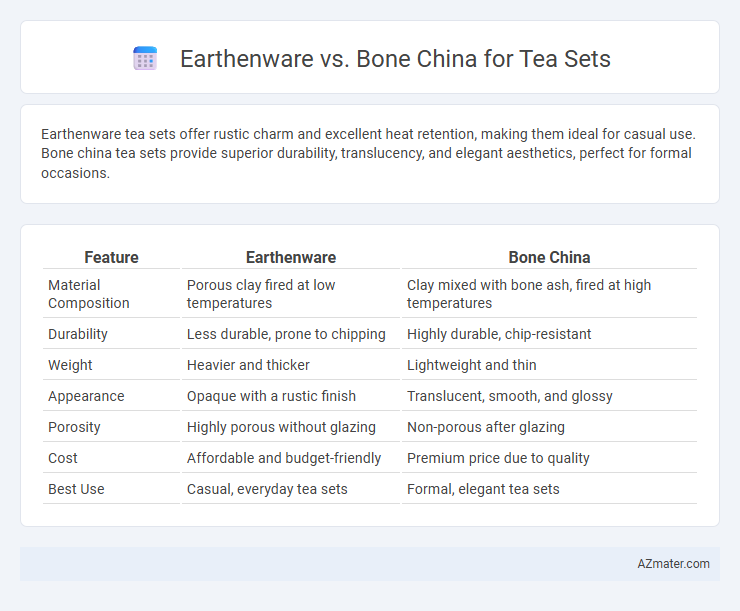Earthenware tea sets offer rustic charm and excellent heat retention, making them ideal for casual use. Bone china tea sets provide superior durability, translucency, and elegant aesthetics, perfect for formal occasions.
Table of Comparison
| Feature | Earthenware | Bone China |
|---|---|---|
| Material Composition | Porous clay fired at low temperatures | Clay mixed with bone ash, fired at high temperatures |
| Durability | Less durable, prone to chipping | Highly durable, chip-resistant |
| Weight | Heavier and thicker | Lightweight and thin |
| Appearance | Opaque with a rustic finish | Translucent, smooth, and glossy |
| Porosity | Highly porous without glazing | Non-porous after glazing |
| Cost | Affordable and budget-friendly | Premium price due to quality |
| Best Use | Casual, everyday tea sets | Formal, elegant tea sets |
Introduction to Earthenware and Bone China
Earthenware tea sets are crafted from porous clay fired at lower temperatures, resulting in a sturdy and rustic appearance ideal for everyday use. Bone china is made from a refined mixture of bone ash, feldspathic material, and kaolin, fired at higher temperatures to achieve exceptional translucency, durability, and a delicate finish. Choosing between earthenware and bone china depends on preferences for aesthetic, weight, and resistance to chipping in tea set collections.
Historical Background of Tea Sets
Earthenware tea sets trace their origins to ancient civilizations such as Mesopotamia and China, where early potters crafted durable and porous clay vessels for everyday use. Bone china, developed in 18th-century England by innovators like Josiah Spode, revolutionized tea sets with its unique combination of bone ash, china clay, and feldspar, offering exceptional whiteness and translucency. The historical evolution of these materials reflects shifting cultural preferences and technological advancements in ceramic production, shaping the tea-drinking experience across centuries.
Material Composition and Manufacturing Process
Earthenware tea sets are made from natural clay fired at lower temperatures, resulting in a porous and heavier material that is often glazed to enhance durability and prevent liquid absorption. Bone china incorporates bone ash, feldspar, and kaolin, fired at higher temperatures to produce a translucent, lightweight, and highly durable ceramic with a smooth finish. The manufacturing process for bone china involves precise blending and multiple firing stages to achieve its strength and delicate appearance, whereas earthenware production is simpler but yields less refined aesthetics and reduced mechanical strength.
Aesthetic Differences: Appearance and Design
Earthenware tea sets often showcase a rustic, handcrafted appearance with matte finishes and textured surfaces, emphasizing organic and natural aesthetics. Bone china tea sets exhibit a delicate translucency, smooth glaze, and refined white or pastel hues with intricate patterns, embodying elegance and sophistication. The contrast in design highlights earthenware's earthy charm against bone china's luxurious, polished appeal.
Durability and Everyday Use
Earthenware tea sets offer moderate durability with a porous structure, making them prone to chipping and staining during everyday use. Bone china tea sets provide superior durability, combining high strength and chip resistance with a non-porous, translucent finish ideal for daily tea service. The choice depends on balancing earthenware's rustic charm against bone china's resilience and ease of maintenance in frequent use scenarios.
Heat Retention and Tea Temperature
Earthenware tea sets excel in heat retention due to their thicker walls and porous structure, maintaining tea temperature longer but cooling gradually. Bone china offers lighter, thinner walls that allow tea to cool faster, providing a delicate balance between heat retention and drinking comfort. For lovers prioritizing sustained warmth, earthenware is ideal, whereas bone china suits those preferring moderate temperature decline for flavor release.
Maintenance and Cleaning Requirements
Earthenware tea sets require gentle hand washing to prevent chipping and avoid abrasive cleaners that can damage the porous surface. Bone china is more durable and resistant to stains, allowing for easier cleaning with mild detergent and sometimes being dishwasher safe. Proper maintenance of both materials enhances longevity, but bone china offers a more low-maintenance option due to its non-porous nature.
Eco-Friendliness and Sustainability
Earthenware tea sets are generally more eco-friendly due to their lower firing temperatures, which reduce energy consumption and carbon emissions compared to bone china. Bone china production involves animal bones and higher energy use, raising sustainability concerns despite its durability and elegance. Choosing earthenware supports biodegradable materials and local craftsmanship, making it a greener option for environmentally conscious tea enthusiasts.
Price Comparison: Affordability and Value
Earthenware tea sets typically offer greater affordability, with prices ranging from $20 to $50 per set, making them accessible for everyday use. Bone china, known for its refined translucency and durability, generally commands higher prices between $80 and $200, reflecting its premium craftsmanship. Choosing earthenware balances cost-effectiveness with aesthetic appeal, while bone china provides long-term value through superior strength and elegant design.
Choosing the Right Tea Set for Your Needs
Earthenware tea sets offer durability and a rustic charm ideal for everyday use, while bone china tea sets provide elegance and delicate translucency suited for formal occasions. Earthenware retains heat longer, enhancing the flavor of stronger teas, whereas bone china's thin walls keep tea warm without altering taste, perfect for subtle infusions. Selecting the right tea set depends on your preference for durability, aesthetic appeal, and the type of tea experience you desire.

Infographic: Earthenware vs Bone China for Tea Set
 azmater.com
azmater.com